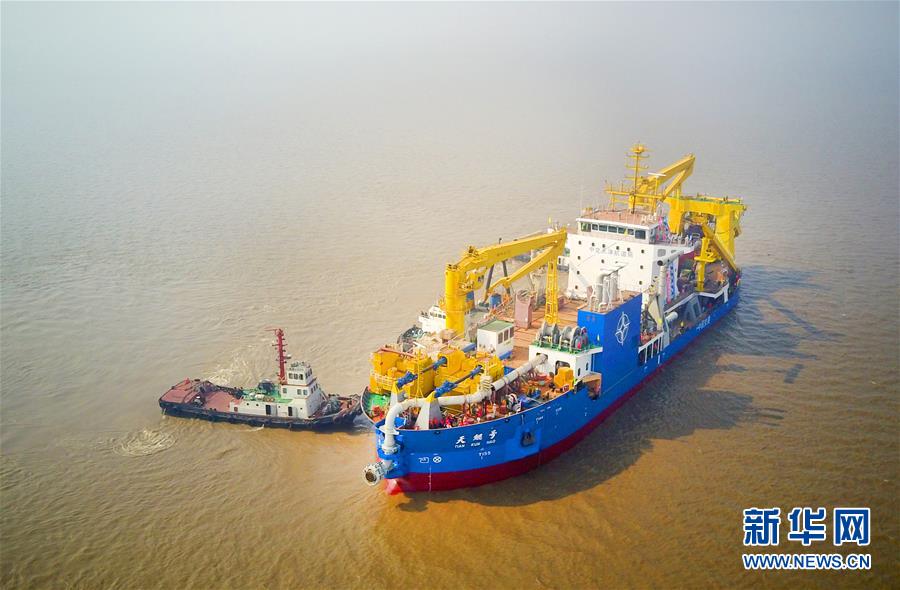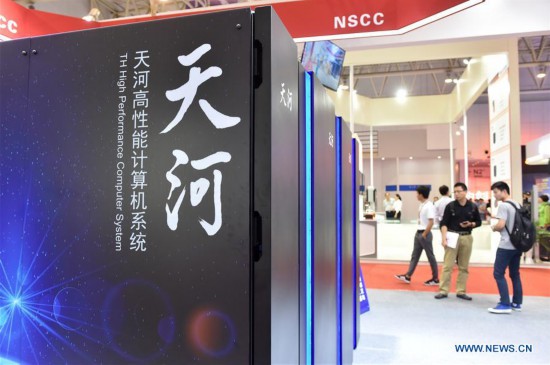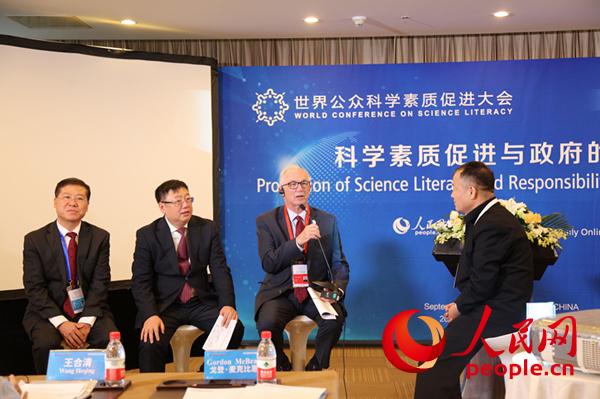

China’s top 10 scientific communication achievements of 2018 were unveiled on Wednesday afternoon at a ceremony held by People’s Daily.
1. China’s FAST discovered a millisecond pulsar for the first time

The world's largest radio telescope, the Five-hundred-meter Aperture Spherical Telescope (FAST), is put into use on Sept 25, 2016, in a mountainous region in Pingtang County of Southwest China's Guizhou province. (Photo/Xinhua)
On Feb. 27, China’s Five-hundred-meter Aperture Spherical Radio Telescope (FAST), the world’s largest single-dish radio telescope, discovered a millisecond pulsar for the first time.
2. Gaofen-5 satellite launched

Gaofen-5 satellite (Photo/Chinanews.com)
On May 9, the Gaofen-5, a hyperspectral imaging satellite, was launched using a Long March 4C rocket from the Taiyuan Satellite Launch Center in Shanxi Province.
3. Yuan Longping's team successfully planted rice in the desert

Students observe the saltwater-tolerant rice cultivated by Yuan Longping's team in Qingdao. (Xinhua/Li Mingfang)
On May 26, renowned Chinese agricultural scientist Yuan Longping and his research team achieved initial success in planting saltwater-tolerant rice in desert areas of Dubai.
4. Tian Kun Hao dredging vessel completed first sea trial

Tian Kun Hao (Photo/Xinhua)
On June 12, Tian Kun Hao, a Chinese-built dredging vessel, the largest of its kind in Asia, completed its first sea trial, which lasted four days.
5. Tianhe-3 exascale supercomputer prototype passed acceptance tests

The prototype of Tianhe-3, a supercomputer capable of at least a billion billion calculations per second, during the 2nd World Intelligence Congress in north China's Tianjin. (Xinhua/Li Ran)
The Tianhe-3 exascale supercomputer prototype, developed by China’s National University of Defense Technology, passed acceptance tests in late July, marking a further step towards China's successful development of the next-generation supercomputer.
6. National Science Day 2018

Students taking part in an activity on the National Science Day. (Photo/Xinhua)
This year, National Science Day was celebrated across China on Sept. 15. It was co-organized by the China Association for Science and Technology, the Publicity Department of the Communist Party of China Central Committee, the Ministry of Education, the Ministry of Science and Technology, the Ministry of Industry and Information Technology and the Chinese Academy of Sciences.
7. First World Conference on Science Literacy held in Beijing

A forum held during the World Conference on Science Literacy (Photo/People's Daily Online)
The first World Conference on Science Literacy opened in Beijing on Sept. 17. With the theme “Science Literacy for a Shared and Better Future,” the Beijing Declaration for Promoting Public Science Literacy Across the World was issued. President Xi Jinping sent a congratulatory message to the conference.
8. Hong Kong-Zhuhai-Macao Bridge opened to traffic

The Hong Kong-Zhuhai-Macao Bridge (Photo/Xinhua)
On Oct. 24, 2018, the world’s longest cross-sea bridge, running 55 kilometers, opened to public traffic. It connects China’s mainland province of Guangdong with the country’s two special administrative regions, Hong Kong and Macao.
9. China’s 2018 Future Science Prize winners announced

The awards ceremony for the Future Science Prize (Photo/www.rmzxb.com.cn)
On Nov. 18, China’s Future Science Prize, one of the country’s most prestigious non-governmental science awards, announced seven winners in Beijing. They were Li Jiayang, Yuan Longping, Zhang Qifa, Ma Dawei, Feng Xiaoming, Zhou Qilin and Lin Benjian.
10. Chang’e-4 lunar probe landed on the dark side of the moon

A simulated landing process of Chang'e-4 lunar probe is seen through the monitor at Beijing Aerospace Control Center in Beijing, capital of China, Jan. 3, 2019 (Xinhua/Jin Liwang)
On Dec. 8, the Chang’e-4 probe was launched by a Long March-3B carrier rocket from the Xichang Satellite Launch Center in southwest China’s Sichuan Province, achieving the first-ever soft landing on the far side of the moon.
 Fire brigade in Shanghai holds group wedding
Fire brigade in Shanghai holds group wedding Tourists enjoy ice sculptures in Datan Town, north China
Tourists enjoy ice sculptures in Datan Town, north China Sunset scenery of Dayan Pagoda in Xi'an
Sunset scenery of Dayan Pagoda in Xi'an Tourists have fun at scenic spot in Nanlong Town, NW China
Tourists have fun at scenic spot in Nanlong Town, NW China Harbin attracts tourists by making best use of ice in winter
Harbin attracts tourists by making best use of ice in winter In pics: FIS Alpine Ski Women's World Cup Slalom
In pics: FIS Alpine Ski Women's World Cup Slalom Black-necked cranes rest at reservoir in Lhunzhub County, Lhasa
Black-necked cranes rest at reservoir in Lhunzhub County, Lhasa China's FAST telescope will be available to foreign scientists in April
China's FAST telescope will be available to foreign scientists in April "She power" plays indispensable role in poverty alleviation
"She power" plays indispensable role in poverty alleviation Top 10 world news events of People's Daily in 2020
Top 10 world news events of People's Daily in 2020 Top 10 China news events of People's Daily in 2020
Top 10 China news events of People's Daily in 2020 Top 10 media buzzwords of 2020
Top 10 media buzzwords of 2020 Year-ender:10 major tourism stories of 2020
Year-ender:10 major tourism stories of 2020 No interference in Venezuelan issues
No interference in Venezuelan issues
 Biz prepares for trade spat
Biz prepares for trade spat
 Broadcasting Continent
Broadcasting Continent Australia wins Chinese CEOs as US loses
Australia wins Chinese CEOs as US loses